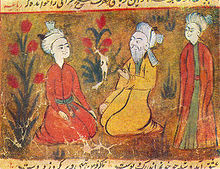Rekhta
| Rekhta | |
|---|---|
 The poem of Ghalib, the notable poet of the 'Rekhta' dialect | |
| Region | Around Delhi |
| Era | 13th-18th centuries[1] |
| Language codes | |
| ISO 639-3 | – |
| Glottolog | rekh1239 |
Rekhta (
The 13th century
Etymology
Rekhtā (from
Origin and usage

As Hindavi began to evolve into a literary language in the 18th century, the term Rekhta carried over to describe this new form. It denoted the Persianized, "high" form of Hindavi used in poetry, as opposed to the speech of the common population. The word was used alongside names like Urdu and Hindi. Its usage in this sense lasted into the 19th century, as evidenced by a
ريختہ کے تُم ہی اُستاد نہیں ہو غالِبؔ
کہتے ہیں اگلے زمانے میں کوئی مِیرؔ بھی تھا
Rēk͟htē kē tum hī ustād nahī̃ hō ġālib, |
You are not the sole grandmaster of Rekhta, Ghalib |
[ɾeːxt̪eː keː t̪ʊm hiː ʊst̪aːd nəɦĩː ɦoː ɣaːlɪb]
[kɛht̪eː hɛ̃ː əɡleː zəmaneː mẽː koiː miːɾ bʰiː t̪ʰaː]
By the eighteenth century however, the term Rekhta had largely fallen out of use and terms like Hindi, Hindustani and Urdu were favored.[3]
Zehal-e-Miskin
Zehal-e-Miskin is the first ghazal in Urdu literature, written by Amir Khusrau, through combining the Old Hindi language Braj Bhasha (Hindavi) and Persian. This Persianised combination was later known as Rekhta (the ancestor of Modern Standard Urdu).[12][13] The poem effectively conveys the agony experienced due to the distance from the beloved. This sentiment is skillfully portrayed through a remarkable fusion of both languages, resulting in a harmonious blend that enhances the overall impact of the poem.[14]
See also
- Dobhashi
- Persian and Urdu
- Rekhti
- Urdu poetry
- [[Rekhta Kultur & Kunskap Projekt / Rekhta Culture & Knowledge Project]]
References
- ^ "Frequently Asked Questions". rekhta.org.
Rekhta is the old name of Urdu. Amir Khusrau, the late 13th Century poet wrote in Rekhta. It changed its name many times and came to be known as Dakkani, Gujari, Hindavi, etc at various points of time. Mir and Ghalib also wrote in Rekhta, which later came to be known as Urdu in the late 19th Century.
- ^ "Rekhta: Poetry in Mixed Language, The Emergence of Khari Boli Literature in North India" (PDF). Columbia University. Archived (PDF) from the original on 28 March 2016. Retrieved 23 April 2018.
- ^ ISBN 978-0-19-906313-0.
- ISBN 9781615301492.
Hindustani began to develop during the 13th century AD in and around the Indian cities of Dehli and Meerut in response to the increasing linguistic diversity that resulted from Muslim hegemony.
- ISBN 978-0-08-087774-7.
Apabhramsha seemed to be in a state of transition from Middle Indo-Aryan to the New Indo-Aryan stage. Some elements of Hindustani appear ... the distinct form of the lingua franca Hindustani appears in the writings of Amir Khusro (1253–1325), who called it Hindwi[.]
- ^ a b c d Rahman, Tariq (2011). From Hindi to Urdu: A Social and Political History (PDF). Oxford University Press. pp. 29–31. Archived from the original (PDF) on 10 October 2014.
- ^ "All writings of Amir Khusraw". rekhta.org.
- ^ Bhattacharya, Vivek Ranjan (1982). Famous Indian sages: their immortal messages. Sagar Publications.
- ISBN 9780521299442.
- ^ Sweta Kaushal (20 September 2015). "Meer Taqi Meer: 10 couplets we can use in our conversations". Hindustan Times (newspaper). Retrieved 18 July 2020.
- ISBN 0-08-044299-4.
- ^ "ze-haal-e-miskin makun taghaful durae nainan banae batiyan". Rekhta website.
Attributed to Amir Khusrau, this is the first ever Ghazal written in Rekhta. The first line of which is in Persian whereas the second is in Hindvi. An extremely popular romantic Ghazal, it has long been a stable for a host of Qawwali singers.
- ^ "Translating Amir Khusrau's 'Zihaal-e-Miskeen', The Ghazal Of Ghazals". Outlookindia.com.
Any translation can be endlessly improved upon, but especially of the ghazal "Zihaal- e-Miskeen" by Amir Khusrau. It is composed in two languages, Persian, and Brij Bhasha — also called "Hindavi" and considered to be an archaic form of what later became Urdu.
- ^ "Zehaal-e-Miskeen -~Amir Khusrau". blindtobounds.blog.
Zehaal -e Miskeen is a master piece written in both the languages in Persian (bold) and Brij Bhasha (italics). In the first verse, the first line is in Persian, the second in Brij Bhasha, the third in Persian again, and the fourth in Brij Bhasha. In the remaining verses, the first two lines are in Persian, the last two in Brij Bhasha. The poem expresses the agony of separation from the beloved, in both the languages with a superb fusion…which to my understanding signifies how different yet similiar [sic] is the expression of the agony of separation amongst the elite ( representing Persian) and the common man ( through Braj Bhasha).
